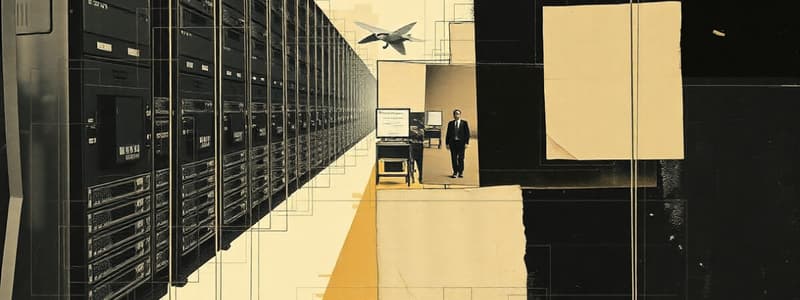Podcast
Questions and Answers
What is a disadvantage of using blocking I/O?
What is a disadvantage of using blocking I/O?
- It may cause delays while waiting for data. (correct)
- It can handle many concurrent clients easily.
- It requires complex event-driven design.
- It efficiently supports long-lived connections.
Which architecture is known for higher fault tolerance?
Which architecture is known for higher fault tolerance?
- Multi-threaded architectures
- Multi-process architectures (correct)
- Single-threaded architectures
- Event-driven architectures
What is a characteristic of event-driven architectures?
What is a characteristic of event-driven architectures?
- They perform well for I/O-bound tasks. (correct)
- They are simpler to implement than multi-threaded models.
- They excel in compute-intensive tasks.
- They reduce resource consumption significantly.
Which of the following statements is true regarding scalability?
Which of the following statements is true regarding scalability?
Which of the following situations would most likely benefit from a multi-threaded architecture?
Which of the following situations would most likely benefit from a multi-threaded architecture?
What is a significant disadvantage of the Frontend + One Worker Process per Client architecture?
What is a significant disadvantage of the Frontend + One Worker Process per Client architecture?
Which of the following is a characteristic of the Single-Threaded Event-Driven Server?
Which of the following is a characteristic of the Single-Threaded Event-Driven Server?
What makes the Multi-Process Multi-Threaded Server with Frontend design robust?
What makes the Multi-Process Multi-Threaded Server with Frontend design robust?
What is a primary use case for the Multi-Process Multi-Threaded Server with Coordinator?
What is a primary use case for the Multi-Process Multi-Threaded Server with Coordinator?
Which server architecture is most efficient for lightweight tasks?
Which server architecture is most efficient for lightweight tasks?
What is a common drawback of the Frontend + One Worker Thread per Client architecture?
What is a common drawback of the Frontend + One Worker Thread per Client architecture?
What requirement must be met for the Multi-Process Event-Driven Server with Coordinator to function?
What requirement must be met for the Multi-Process Event-Driven Server with Coordinator to function?
Which server architecture may become a bottleneck under high load?
Which server architecture may become a bottleneck under high load?
Flashcards
Worker crashes impact
Worker crashes impact
Worker crashes have a limited impact on the application in high-concurrency systems.
Blocking I/O
Blocking I/O
Blocking I/O is simple but can delay the application when awaiting data.
Event-driven architecture
Event-driven architecture
Event-driven architectures are good for I/O-bound tasks.
Scalability (concurrency)
Scalability (concurrency)
Signup and view all the flashcards
Fault tolerance (architectures)
Fault tolerance (architectures)
Signup and view all the flashcards
Frontend + One Worker Process per Client
Frontend + One Worker Process per Client
Signup and view all the flashcards
Frontend + One Worker Thread per Client
Frontend + One Worker Thread per Client
Signup and view all the flashcards
Single-Threaded Event-Driven Server
Single-Threaded Event-Driven Server
Signup and view all the flashcards
Multi-Process Multi-Threaded Server (Frontend)
Multi-Process Multi-Threaded Server (Frontend)
Signup and view all the flashcards
Multi-Process Multi-Threaded Server (Coordinator)
Multi-Process Multi-Threaded Server (Coordinator)
Signup and view all the flashcards
Multi-Process Event-Driven Server with Coordinator
Multi-Process Event-Driven Server with Coordinator
Signup and view all the flashcards
Scalability Limitations (Processes)
Scalability Limitations (Processes)
Signup and view all the flashcards
Server Crash Impact (Frontend and Threads)
Server Crash Impact (Frontend and Threads)
Signup and view all the flashcards
Study Notes
Server Architecture Types
-
Frontend + One Worker Process per Client:
- A new process is created for each client connection.
- Simple implementation, but scalability limited by memory usage.
- Worker process crashes only affect one client.
- Suitable for servers with few clients (e.g., SSH).
-
Frontend + One Worker Thread per Client:
- A new thread is created per client connection.
- Faster response, lower memory use compared to process-based approach.
- Thread crashes affect all clients.
- Potential issues with shared resources (e.g., file descriptors).
- Suitable for moderate client loads with acceptable blocking I/O.
-
Single-Threaded Event-Driven Server:
- A single thread handles all clients using an event-driven model.
- Requires non-blocking I/O operations.
- Efficient for I/O-bound servers (low resource use).
- Complex to implement, does not leverage multi-core processors.
- Server crash affects all clients.
- Suitable for serving static webpages or lightweight tasks.
-
Multi-Process Multi-Threaded Server with Frontend:
- Frontend accepts connections, delegates to multi-threaded worker processes.
- Combines multi-process and multi-thread advantages.
- Worker crashes have limited impact.
- Frontend can become a bottleneck under heavy loads.
- Suitable for scalable, robust applications needing concurrency.
-
Multi-Process Multi-Threaded Server with Coordinator:
- Worker processes/threads handle client requests, coordinator for privileged operations.
- Distributes load, isolates worker crashes.
- Reduced communication bottlenecks.
- Needs efficient kernel load balancing.
- Potential scalability limits due to memory consumption.
- Suitable for fault-tolerant systems with decentralized control.
-
Multi-Process Event-Driven Server with Coordinator:
- Uses event-driven workers, coordinator for privileged tasks.
- Requires non-blocking I/O.
- Highly scalable, isolates worker crashes for increased robustness.
- Efficient for high concurrency and short-lived connections.
- Complex implementation.
Key Considerations
-
Blocking vs. Non-Blocking I/O:
- Blocking I/O is simpler but can delay responses.
- Non-blocking I/O avoids delays but requires event-driven design.
-
Scalability:
- Multi-threaded and event-driven handle more clients but are more complex.
- Multi-process architectures are robust but take more resources.
-
Fault Tolerance:
- Multi-process architectures are more resilient due to isolated processes.
- Multi-threaded or single-threaded architectures are less resilient.
-
Performance:
- Event-driven architectures excel with I/O-bound tasks.
- Multi-threaded and multi-process better suit compute-intensive tasks.
Studying That Suits You
Use AI to generate personalized quizzes and flashcards to suit your learning preferences.




